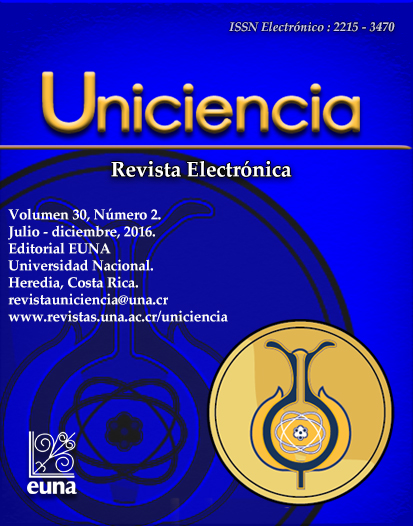Measurement of Carbon Footprint at National University of Costa Rica for 2012-2014. Heading for Carbon Neutrality
DOI:
https://doi.org/10.15359/ru.30-2.4Keywords:
Carbon neutrality, environmental indicators, carbon dioxide, greenhouse effect, inventory.Abstract
Quantifying and measuring environmental indicators such as carbon footprint allows to plan measures aimed towards an improvement of the conditions that are conducive to a positive impact on the environment, minimizing or mitigating emissions of carbon dioxide and other gases that accelerate the greenhouse effect. The National University of Costa Rica (UNA, in Spanish) seeks to make the annual measuring of this indicator, in order to implement policies and actions that integrate the entire university population routed to a good sustainable development of the institution. In that sense, parallel to the raised national goal of carbon neutrality, UNA seeks to contribute in efforts to mitigate, minimize or compensate the environmental impact, with a comprehensive commitment of its staff and its students. The objective of this study is to quantify and update carbon footprint at UNA for the 2012-2014 period, to be able to analyze and compare its behavior through time, according to the applicable aspects referred to in the calculation. For the inventory of greenhouse gases (GHG) the methodology applied was endorsed by the National Meteorological Institute (IMN, for its initials in Spanish), using timekeeping factors, specified in the Manual of Greenhouse Gases Emission Factors, in its fourth edition, 2014. As a result, between the years 2012 to 2014 a 22% increase of carbon footprint was obtained, going from the equivalent of 2,906 to 3,568 tonnes of CO2. The above due to increases in various aspects, as the number of people in the institution, as well as the pollution emitted by air travel. The intention of these results is to identify increases or decreases in emissions and establish strategies or specific environmental measures for their reduction.References
Banco Mundial. (2015). Emisiones de todos los gases de efecto invernadero (toneladas métricas per cápita). Indicadores del desarrollo mundial. Centro de Análisis de Información sobre Dióxido de Carbono, División de Ciencias Ambientales del Laboratorio Nacional de Oak Ridge, Tennessee, Estados Unidos. Disponible en: http://datos.bancomundial.org/indicador/EN.ATM.CO2E.PC/countries/
Benavides & Sánchez. (2011). Indicadores ambientales para una política C-neutral en Costa Rica. El caso de la Universidad Nacional. Revista Recursos Naturales y Ambiente, 56-57, 138-144 .
Fundación Terra. (2008).Guía "X un buen clima. Calculadora de carbono. Una guía de acción contra el cambio climático". Fundación Terra y Consell Assessor per al Desenvolupament Sostenible CADS. Disponible en: http://www.terra.org/calc/index
Global Footprint Network. (2015). Huella de Carbono. 7 mayo, 2015, de GFN Extraído de: http://www.footprintnetwork.org/es/index.php/GFN/page/carbon_footprint/
Huella de Carbono. (2009). ¿Qué es la Huella de Carbono? 30 abril, 2015, de APB internet. Extraído de: http://www.huellacarbono.es/apartado/general/huella-de-carbono.html
IMN (Instituto Meteorológico Nacional, C.R.). (2014). Factores de emisión de gases de efecto invernadero (4ta edic.). Autor.
IMN (Instituto Meteorológico Nacional, C.R.). (2009). Guía para la elaboración de acciones en cambio climático. Segunda Comunicación Nacional. Autor.
INTE 12-01-06:2011/Cor.2. (2013). Norma nacional para demostrar la C- neutralidad. Requisitos. Instituto de Normas Técnicas de Costa Rica Norma INTECO.
ISO 14067:2013. Requisitos y directrices para la cuantificación y comunicación de la huella de carbono de un producto (HCP) en base a las normas internacionales de evaluación del ciclo de vida.
MINAE (Ministerio de Ambiente y Energía, C.R.), IMN (Instituto Meteorológica Nacional, C.R.). (2014). Inventario nacional de gases de efecto invernadero y absorción de carbono 2010. San José, Costa Rica: Autor.
MINAET (Ministerio de Ambiente, Energía y Telecomunicaciones, C.R.), MS (Ministerio de Salud, C.R.). (2011). Guía para la elaboración de Programas de Gestión Ambiental Institucional (PGAI) en el sector público de Costa Rica. Documento de orientación para las Instituciones Públicas. San José, Costa Rica: Autor.
Programa UNA Campus Sostenible, Universidad Nacional de Costa Rica. (2014). Sistema de indicadores y base de datos. UNA Carbono Neutral-Inventario.
Downloads
Published
Issue
Section
License
Authors who publish with this journal agree to the following terms:
1. Authors guarantee the journal the right to be the first publication of the work as licensed under a Creative Commons Attribution License that allows others to share the work with an acknowledgment of the work's authorship and initial publication in this journal.
2. Authors can set separate additional agreements for non-exclusive distribution of the version of the work published in the journal (eg, place it in an institutional repository or publish it in a book), with an acknowledgment of its initial publication in this journal.
3. The authors have declared to hold all permissions to use the resources they provided in the paper (images, tables, among others) and assume full responsibility for damages to third parties.
4. The opinions expressed in the paper are the exclusive responsibility of the authors and do not necessarily represent the opinion of the editors or the Universidad Nacional.
Uniciencia Journal and all its productions are under Creative Commons Atribución-NoComercial-SinDerivadas 4.0 Unported.
There is neither fee for access nor Article Processing Charge (APC)






